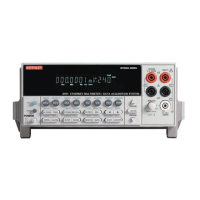Model 2701 User’s Manual SCPI Signal Oriented Commands 13-7
READ?
Description This command is typically used with the instrument in the “one-shot”
measurement mode to trigger and acquire a specified number of
readings. The SAMPle:COUNt command is used to specify the number
of readings (see Trigger Subsystem). Note that with sample count >1,
the readings are stored in the buffer.
When this command is sent, the following commands execute in the
order they are presented:
ABORt
INITiate
FETCh?
When ABORt is executed, the instrument goes into the idle state if
continuous initiation is disabled. If continuous initiation is enabled, the
operation re-starts at the beginning of the Trigger Model.
If the instrument is in the idle state, INITiate takes the instrument out of
the idle state. If continuous initiation is enabled (INITiate:CONTinuous
ON), then the INITiate command generates error -213 (init ignored).
NOTE If continuous initiation is enabled, the READ? command will generate
error -213 (init ignored). It can be disabled by sending INITiate:CONTinuous
OFF. The *RST command can also be used to disable continuous initiation. It
also places the Model 2701 in the “one-shot” measurement mode:
*RST ‘ Disable continuous initiation and place 2701 in “one-shot” mode.
READ? ‘ Trigger and return one reading.
NOTE When readings are stored in the buffer by the TRACe command (or by front
panel data store operation), INIT and multi-sample READ? queries are locked
out. With readings in the buffer that were stored in that manner, you cannot use
the INIT or READ? command if sample count is >1 (error -225, out of memory).
Buffer operation is covered in Section 6.
The buffer of the Model 2701 is nonvolatile. Therefore, readings stored in the
buffer are not lost when the instrument is turned off or when *RST or
SYSTem:PRESet is sent. When writing test programs that perform multi-sample
measurements (SAMPle:COUNTt >1), you may want to add the TRACe:CLEar
command at the beginning to clear the buffer. However, be careful not to
inadvertently clear stored readings that are needed.

